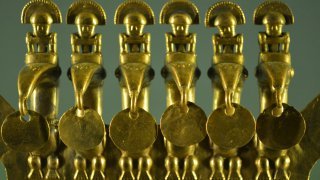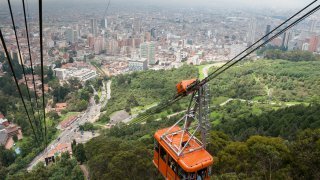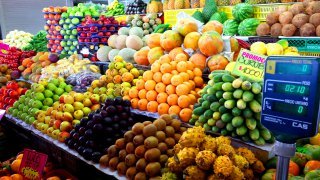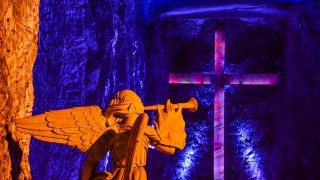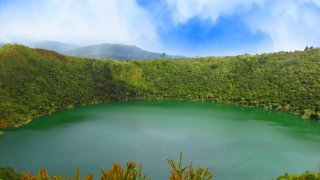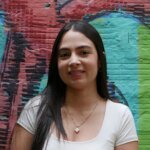Bogotá is often considered sprawling, with lots of traffic jams, and cold in comparison to the exotic Cartagena or Medellín, the city of eternal spring. Some travellers choose to skip the Colombian capital, wrongly: the city has a rich historical and cultural heritage and offers to its visitors endless outings and activities possibilities.
Bogotá basics
Bogotá, an Andean city
Nestled in the Cordillera Oriental north of the Andes, the Colombian capital spreads out at the bottom of a mountain chain in the centre of the country. It culminates at 2640 meters above sea level, making it the 3rd highest capital in the world after La Paz and Quito.
To the east of the city, two cerros (hills) stand like ramparts to look after it: Monserrate and Guadalupe, on which are respectively perched a basilica and a chapel making the two hills true pilgrimage sites.
The climate in Bogotá
Perched at more than 2600 meters above sea level, Colombia’s largest city has a mild high-altitude climate. The average temperature over the year is around 14°C, but it can vary between 9 and 20°C on the same day: T-shirts and sweaters are therefore both to be packed. Bogotá has two rainy seasons, from March to May and from October to November, but you will often have to deal with the fog that invades the plateau on which the city is located.
History of the Colombian capital
The main pre-Colombian civilization that lived around Bogotá is the community of the Muiscas, a branch of the Chibchas that occupied the northern Andes from the 3rd century onwards. In search of El Dorado, the conquistador Gonzalo Jiménez de Quesada invaded the region in 1536 and founded the city in 1538.
It gradually prospered until it became the capital of Greater Colombia, a large country made up of what is now Colombia, Ecuador, Venezuela and Panama, which was formed after the independence of part of South America from Spain. When it was dissolved in 1830, Bogotá became the capital of present-day Colombia.
What to do in Bogotá
Museums: Colombian art and culture
In Bogotá, there’s no shortage of museums! If you don’t have much time in the Colombian capital, we suggest you focus on the following 3: the Gold Museum, the Botero Museum and the International Emerald Museum, all located in the historic Candelaria district.
The Gold Museum, which reopened in 2009, has unique pieces from around the world that will give you a glimpse of the incredible goldsmithing skills of pre-Colombian civilizations and, above all, the importance of this precious metal in their belief system.
The Botero Museum features some 123 works by the world-famous painter-sculptor Fernando Botero. Originally from Medellín, the artist with his round and voluptuous figures imposed a unique style and is today the pride of Colombians. This (free) museum is a must!
Did you know that Colombia was the first country to export emeralds? The International Emerald Museum, located a stone’s throw from the Gold Museum, is dedicated to this Colombian treasure. Inside, a real mine has been reconstructed to allow the visitors to discover the process of formation and extraction of the emeralds.
The candelaria: a walk in the historic district
If you decide to visit the three museums mentioned above, this is your chance to stroll around the beautiful Candelaria district. With a colonial style architecture, the colourful houses follow one another and take you back 300 years in time. Here the past meets the present: you will discover street art works in which the artists tell the story of the country’s recent evolution and the incredible resilience of its inhabitants who are resolutely looking towards the future. Historic buildings and urban art blend together perfectly!
Our favorite place in the neighborhood? La Plazoleta del Chorro! There, in the evening, the main square turns to a street performances stage that the Bogotanese like to watch sitting on a bench with a hot drink in their hand. It is here, incidentally, that the city is said to have been founded. On the corner of the street, Calle del Embudo is full of small bars and cafés, handcraft shops and murals.
A stop at this part of Bogotá is also an opportunity to walk along the Plaza Bolívar, surrounded by important monuments: the Palace of Justice, the City Hall, the National Capitol and the Primada Cathedral.
Monserrate: the best view of Bogotá
Another must-see in the city is the Monserrate hill located to the east of the city and culminating at 3152 meters above sea level. At the top of the hill is the Basilica of Señor Monserrate, built in 1925 after an earthquake destroyed the chapel that had stood there since the 17th century.
If it is not religion that brings you to this hill, it will have to be the view of Bogotá. From up there, the immensity of the Colombian capital will surprise you: from on all sides, the buildings rise up and spread out over the plateau. The city seems to extend to infinity and has no limits!
There are three options for getting there. If climbing the 600m high hiking trail doesn’t scare you, you should know that it is open from 5am to allow you to see the city wake up. If you don’t feel like climbing, you can reach the top by funicular or cable car and enjoy a sunset over the Colombian city.
Markets: shopping in Bogotá
Bogotá has almost 20 markets and some of them are real institutions. Our favourite, the Paloquemao market, is highly recommended for gourmets. Installed in a former railway warehouse, this fruit and vegetable market is the ideal place to taste exotic Colombian fruits and discover the incredible diversity of what grows in the country. Explosion of flavours and colours guaranteed!
Just a stone’s throw from Bolívar Square is Pasaje Rivas, the city’s first commercial thoroughfare. Here many merchants sell handcrafts. Pottery, hammocks, jewellery, hats, wicker baskets, this is the place to go if you are looking for small souvenirs to take back to your loved ones.
If you are passing through Bogotá on a Sunday, the San Alejo flea market is a must. Gathering up to 300 exhibitors, it is the meeting place for families who like to stroll around in search of ancient and small treasures. In this eclectic market you can find everything from shoes, crockery, antique furniture, books and other curiosities of all kinds!
Parks: a nature break in the city
If you feel like taking a little nature break while exploring the city of Bogotá, there are several options available to you.
To familiarize yourself with the different ecosystems and the diversed flora that you will encounter during your trip to Colombia, there is nothing like spending half a day in the José Celestino Mutis Botanical Garden in the northwest of the city.
In its greenhouses you will find hundreds of species of plants and flowers from different regions of the country, from the Amazon to the Caribbean, the Andes and the paramo. Among the collections, don’t miss that of orchids: the national flower of Colombia, there are more than 4,000 species in the country!
To have a picnic, read a book, play sports or simply enjoy a nap in the sun, the perfect place is the Bolívar Park. With more than 113 hectares it is the largest park in the city. It has some 16 kilometres of paths for walking, running or cycling, a large lake for boating, and hundreds of trees under which to settle down and forget for a moment that you are in the middle of the buildings.
Events: when to visit Bogotá?
If you visit the Colombian capital all year round, you might be lucky enough to come accross one of the cultural events that punctuate the life of the city.
In April, every year since 1988, the Bogotá International Book Fair (FILBo) is held. For two weeks, the Colombian capital becomes one of the largest bookstores in the world and promotes the development of reading in the country. In 2020, it will be northern literature that will be in the spotlight.
In June, the Bolívar Park turns into an open-air concert hall as it hosts the Rock al Parque Festival, a free event that showcases national and international artists. This popular festival has been declined and Bogotá’s people also gather here in October for Hip Hop al Parque and in November for Salsa al Parque.
In August it is the appointment of the gourmets with the Alimentarte festival which gathers the greatest Colombian chefs during 5 days. During the first part of the festival, a guest country is honored, before giving pride of place to a region of the country (different each year) for the last days. Buen provecho! (Bon appétit !)
You can also find the Festival Iberoamericano de Teatro de Bogotá in July every two years and the Bogotá Film Festival in October.
Our tips for visiting Bogotá
When to go to Bogotá?
The Colombian capital is best visited at the beginning of your stay (international flights often arrive there). The visit can also be completed by an extra half-day at the end of your stay before taking your return flight.
Our practical advice
To fully enjoy the city, we advise you to :
- Bring warm clothes. Bogotá is located at an altitude of 2600m, so it can be a little cold.
- Put on good shoes. If you plan to walk around the city and discover its markets, museums and parks, choose comfortable shoes.
- Pack sunscreen and an umbrella in your backpack! At such an altitude, the sun is strong, so caps, sunscreen and sunglasses can be very much appreciated. On the other hand, in Bogotá, you are never safe from a sudden shower…
- Moisturize well. Altitude may surprise your body at first if it is not accustomed to it. Drink plenty of water and lighten your schedule for the first few days to give yourself some rest if necessary.
- Follow the guide! To fully understand the history of the city and all its treasures, we can only advise you to discover it with a guide. Contact us so that we can organise your stay in the capital.
What to do around Bogotá
Visit the Salt Cathedral of Zipaquirá
Close to the city and still in the department of Cundinamarca, you can stop in Zipaquirá to visit its Salt Cathedral, one of the most visited places in Colombia.
Carved into the walls of the salt mines of the same name, 180 meters underground, the Salt Cathedral is a replica of the first one built in the 1950s that was threatening to collapse. It is accessed via a tunnel representing the Stations of the Cross, and one moves through enormous cavities until reaching the naves of the cathedral.
In addition to discovering a unique place, this visit is an opportunity to learn more about the conditions in which a monument of this scale was built, the history of the region’s mines and the work of the miners.
Spend a day in the Nemocón salt mine
30 minutes drive from Zipaquirá is the little sister of the Salt Cathedral: the Nemocón salt mine. Just like its elder sister, it is worth a visit: accompanied by a guide you will dive 80 metres down and take the same path as the miners who have worked in this mine for centuries.
In one of its large chambers you will be able to observe the “heart of Colombia”, a salt crystal carved in the shape of a heart.
This unique place was also the setting for the Chilean-American film The 33 with Antonio Banderas and Juliette Binoche, which tells the story of the 33 Chilean miners stranded in a copper mine in the Atacama Desert in 2010.
Discover the Guatavita Lagoon
Still north of Bogotá, at an altitude of 3,000 meters, is the Guatavita lagoon. This perfectly round lake, whose origin is still unknown today, was sacred to the Muiscas, a pre-Colombian people living in the area before the arrival of the conquistador Gonzalo Jiménez de Quesada.
Around this lagoon, to honour their gods, they performed ceremonies in which offerings, especially gold, were thrown into the water. These rituals contributed in part to the creation of the myth of El Dorado that led the conquistadores to these lands.
Accompanied by an official park guide you can walk around the lagoon and learn more about the ecosystem of the region, the muisca culture and the history of this very special lake.
Hiking in Chingaza and Chicaque National Parks
To stretch your legs and get a complete change of scenery, we recommend a hike in the Chingaza National Park, 1.5 hours from Bogotá.
Located between 3000 and 3800 meters above sea level, the park offers exceptional paramo landscapes, you will see frailejones, these shrubs that are only found at high altitudes. Among the fauna, the famous spectacled bear but also the puma or the Andean condor. In order to preserve this great biodiversity, access to the park is controlled and the reservation of entries is mandatory.
If you prefer to travel at a lower altitude, head south to the capital and the Chicaque National Park. This cloud forest covered with constant fog will immerse you in a unique mysterious atmosphere. Here too, you may see spectacled bears, but also armadillos and hummingbirds. The park has 18 km of ecological trails that will allow you to discover this very special ecosystem.
Fancy visiting Bogota? Contact our local experts..



